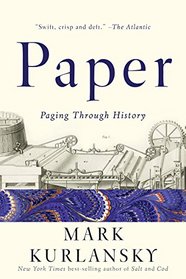This book starts with the fascinating study of how papermaking got started, where, and how things changed. Before long, however, this merged into the history of printing. This too was interesting in the way printing popped up in different locations with different sources for the paper used. I was also surprised to learn about the craft of making paper and the fact that people (men, women, and children) who worked in the field only lived until about the age of 30. Using children to scrub the vats on Sundays was a real surprise.
In some ways, this is a nostalgic look back at my father; he worked with paper all his life as a bookbinder. It always amazed me that he could tell one side of the paper from the other just by its feel. He had a real appreciation for fine papers.
Near the end of the book, the author turns to the current papermaking traditions of China, Japan, and other countries. Like so many other traditions, papermakers are trying to preserve their standards and methods. What they note, however, is that the mechanical methods of making paper are now so good that most people cannot tell the difference. If someone cannot tell the difference, why would that person pay the extra money for the real thing?
In the last years, there has grown a stronger relationship between an artist and the papermaker. One papermaker laughingly told the author that watercolorists were 'the worst.' The watercolorist is the most difficult artist to satisfy because they are so definite about the absorbency that they need for their projects. Who knew? Overall score = 4.5 stars
In some ways, this is a nostalgic look back at my father; he worked with paper all his life as a bookbinder. It always amazed me that he could tell one side of the paper from the other just by its feel. He had a real appreciation for fine papers.
Near the end of the book, the author turns to the current papermaking traditions of China, Japan, and other countries. Like so many other traditions, papermakers are trying to preserve their standards and methods. What they note, however, is that the mechanical methods of making paper are now so good that most people cannot tell the difference. If someone cannot tell the difference, why would that person pay the extra money for the real thing?
In the last years, there has grown a stronger relationship between an artist and the papermaker. One papermaker laughingly told the author that watercolorists were 'the worst.' The watercolorist is the most difficult artist to satisfy because they are so definite about the absorbency that they need for their projects. Who knew? Overall score = 4.5 stars




